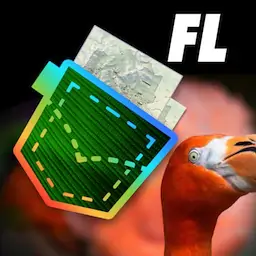BrochureSavannas |
Brochure of Savannas Preserve State Park in Florida - the largest freshwater marsh system on Florida’s southeast coast. Published by Florida State Parks.
featured in
| Florida Pocket Maps |  |
source
SAVANNAS PRESERVE
STATE PARK
HISTORY & NATURE
The Savannas is comprised of thirteen natural
communities: pine flatwoods, wet prairie, basin
marsh, marsh lake, sand pine scrub and scrubby
flatwoods. Each community is characterized by
a distinct population of plants and animals that
are naturally associated with each other and their
physical environment.
Of particular interest is the sand pine scrub, a
globally imperiled plant community covering the
eastern boundary of the park. It is dominated by
sand pines and is home to the Florida scrub-jay and
gopher tortoise. Rare plant species, like the prickly
apple cactus, Lakela’s mint and four-petal pawpaw,
dot the landscape.
The basin marsh covers nearly 1,500 acres. The
landscape changes dramatically with the rainfall
as does the wildlife that lives here. The deeper
marsh lakes provide habitat for largemouth bass,
alligators, waterfowl and bald eagles.
Archaeological evidence suggests native
occupation of the area approximately 7,000 years
ago. These native peoples inhabited the Atlantic
Ridge, relying on the rich fauna and flora of the
nearby Indian River.
During the Second Seminole War (1835-1842),
Lt. Colonel Benjamin Pierce first used the term
‘savannah’ to describe a series of ponds and
marshes found here. In 1879, Captain Thomas
Richards planted the first pineapples, grown
from cuttings he transported from Key West. The
plants thrived in the sandy, well-drained soils and
dozens of plantations appeared along the Atlantic
Ridge. African Americans and Bahamians provided
plantation labor working the fields in extremely
uncomfortable conditions. From 1895 to 1920,
Jensen Beach was known as the “Pineapple Capital
of the World.”
2541 Walton Road
Port St. Lucie, FL 34952
772-398-2779
www.friendsofsavannas.org
PARK GUIDELINES
Please remember these tips and guidelines, and enjoy
your visit:
•
•
•
•
•
•
•
•
•
•
Hours are 8 a.m. until sunset, 365 days a year.
The Education Center is open 9 a.m. until 5 p.m.,
Thursday through Monday
An entrance fee is required.
All plants, animals and park property are protected.
Collection, destruction or disturbance is prohibited.
Pets are permitted in designated areas only. Pets
must be kept on a leash no longer than 6 feet and
well behaved at all times.
Equestrian activities are prohibited on the
Atlantic Coastal Ridge due to the sensitivity of this
endangered natural community.
Only electric outboard motors are permitted in
designated areas.
Fireworks and hunting are prohibited in all Florida
State Parks.
Alcoholic beverage are not allowed.
Inquire at the Education Center to volunteer.
SAVANNAS
PRESERVE
STATE PARK
Florida’s state parks are committed to providing
equal access to all facilities and programs.
Should you need assistance to enable your
participation, please contact the Education
Center at 772-398-2779.
Visit us online at
FloridaStateParks.org
Follow us on social media
FloridaStateParks.org
#FLStateParks
Largest freshwater marsh system
on Florida’s southeast coast
Savannas Preserve State Park
Edwards Road
N
Indian River Lagoon
Aquatic Preserves
Field Office
South 25th Street
EXPERIENCES AND AMENITIES
Canoe Launch
Easy Street
Education Center
Ankona
Fishing
Indian
River
Hiking
Trailhead
Equestrian Trail
Parking
v
Dri
Picnic Area
e
00241_Rev_12.18
Hutchinson
Island
er
The Park entrance at Jensen Beach Boulevard is the
southernmost trailhead and offers park visitors a
leisurely 1.5 mile hike to the marsh overlook. It has a
picnic pavilion and restroom facilities.
White City
Canoeing
Riv
North Fork
St. Lucie River
Pavilion
Restrooms
Trailhead
Wildlife Viewing
Walton
Walton Road
Port St. Lucie
Park Boundary
Office
Education
Center
r
Park Road Unstabilized
Hiking Trail
Multi-use Trail
Park Boundary
Rive
Park Road Stabilized
Legend
ucie
From the Walton Road entrance, hikers, bicyclists
and horseback riders share more than 8.5 miles
of multi-use trails. An equestrian area, located off
nearby Scenic Park Drive, can easily accommodate
trailers with plenty of space to unload horses.
Biking
ian
Numerous interpretive activities are available to
school groups and park visitors, including guided
walks and kayak/canoe trips. Kayaking and canoeing
are good ways to explore the Savannas, water levels
permitting. A launching area is located .75 miles
from the Education Center and affords visitors easy
access to the basin marsh. A second launching
area is located at the Evans Creek area on U.S. 1,
offering visitors access to North Fork of the St. Lucie
River. A small picnic pavilion and environmentallyfriendly restroom are located nearby. For additional
information, or to reserve a tour, please call the
Education Center at 772-398-2779.
d
Ind
Begin by visiting the Education Center located off
Walton Road. The award-winning facility features
interactive exhibits and displays on local history,
the preserve’s natural communities, plant and
animal species and how the Florida Park Service is
managing the park for future generations to enjoy.
The center also features live animal exhibits.
E
S
Atlantic
Ocean
oa
yR
a
dw
i
M
St. L
Encompassing more than 6,800 acres and stretching
more than 15 miles from Ft. Pierce to Jensen Beach,
Savannas Preserve State Park contains the largest,
most ecologically intact stretch of freshwater marsh
in southeast Florida. The park offers visitors a variety
of ways to explore and learn about this natural area.
W
Oleander Avenue
Fort Pierce
South
Eden
US Highway
County
Line
Road
State Road
County Road
Directions
Park Road Stabilized
Road Unstabilized
Savannas Preserve Park
State
Park is
Walkways
located approximately 2 miles east of
Hiking Trail
U.S. 1 on Walton Road
in Port St. Lucie.
Hiking/Biking/Equestrian Trail
Hawk’s
Bluff
Trail
Jenson Beach Boulevard

